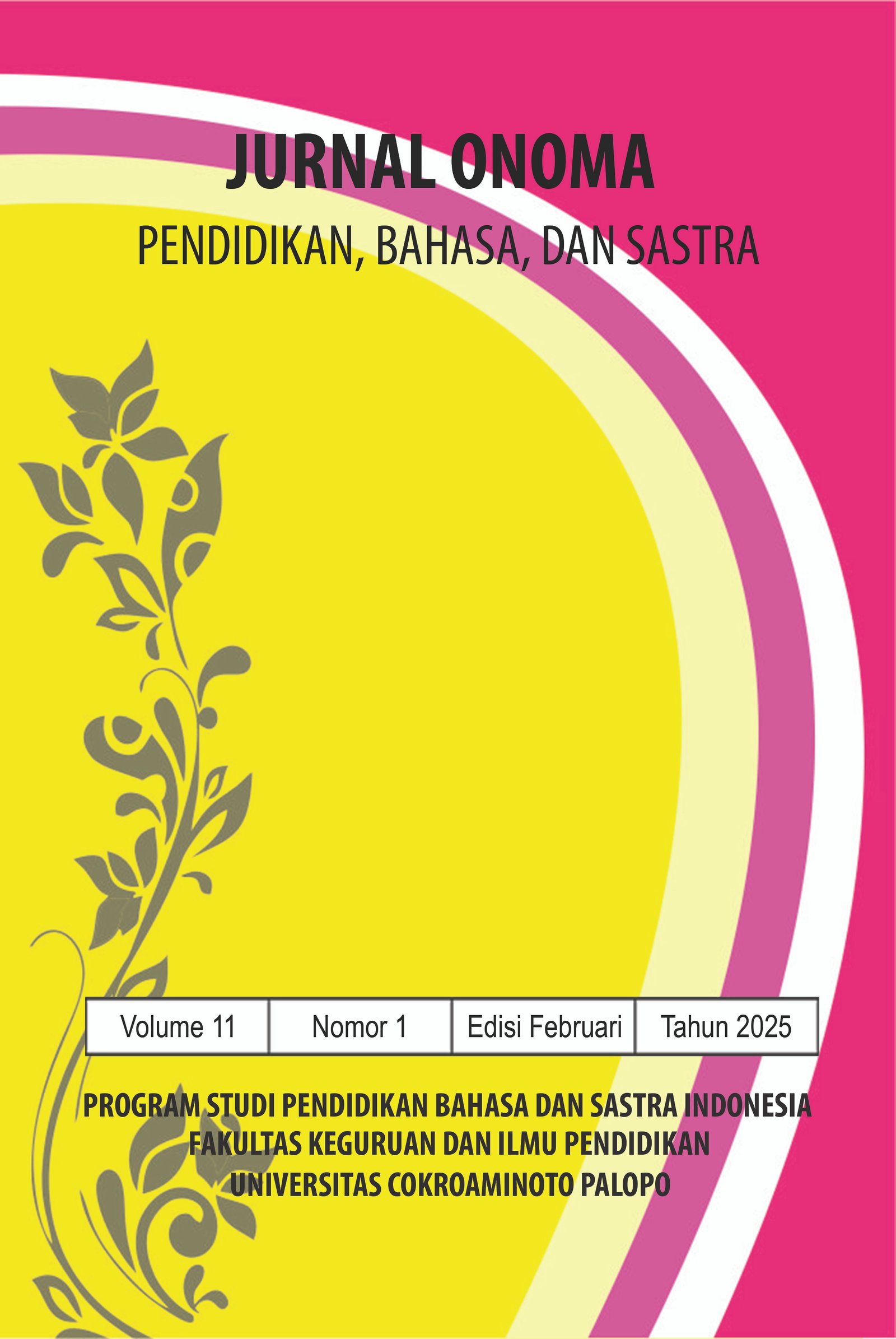Girl Power dalam Film Animasi Barbie: Thumbelina (2009) Produksi Mattel Sebagai Karya Adaptasi
https://doi.org/10.30605/onoma.v11i1.4892
Keywords:
cerita klasik, Thumbelina, film Barbie, Girl Power, Subjektivitas PerempuanAbstract
Penelitian ini bertujuan untuk menunjukkan bagaimana wacana girl power sebagai bagian dari feminisme gelombang ketiga direpresentasikan dalam film animasi Barbie: Thumbelina (2009) produksi Mattel yang merupakan adaptasi dari cerita klasik “Thumbelina” (1835) karya Hans Christian Andersen. Untuk mencapai tujuan, penelitian ini menggunakan metode deskriptif kualitatif dengan teori adaptasi dari Linda Hutcheon (2006) yang dipadukan dengan konsep girl power dalam konteks feminisme gelombang ketiga. Teori adaptasi Linda Hutcheon (2006) digunakan untuk menganalisis transformasi tekstual pada penokohan Thumbelina dan narasi penceritaan. Kemudian, analisis ideologis dilakukan dengan menggunakan konsep girl power dalam konteks feminisme gelombang ketiga. Dari kajian ini disimpulkan bahwa film animasi Barbie: Thumbelina (2009) produksi Mattel menunjukkan subjektivitas perempuan dengan menempatkan Thumbelina sebagai subjek aktif yang mampu memimpin, bertindak, dan menyelesaikan masalah tanpa ketergantungan pada pihak lain. Hal tersebut mencerminkan nilai-nilai pemberdayaan perempuan yang menjadi inti dari konsep girl power, seperti kemandirian, ekspresi diri, dan keberagaman.
Downloads
References
Baumgardner, J., Richards, A., & Harris, A. (2004). All about the girl: Culture, power, and identity.
Chang, T. C. (2020). A Mute Clamor for Release”: Rewriting Andersen in Emma Donoghue’s “The Tale of the Bird. Traditions and Difference in Contemporary Irish Short Fiction: Ireland Then and Now, 43-50.
Currie, D., Kelly, D. M., & Pomerantz, S. (2009). 'Girl power': girls reinventing girlhood (Vol. 4). Peter Lang.
Fadzilah, R. M., Untari, L., & Purnomo, S. L. A. (2017). A Semiotics Study Of Characterization On The Movie And Visual Novel Adaptations Of Andersen’s Thumbelina. Leksika: Jurnal Bahasa, Sastra dan Pengajarannya, 11(2), 12.
Helm, H. J. (2023). “She was no taller than your thumb. So she was called Thumbelina”: Gender, Disability, and Visual Forms in Hans Christian Andersen’s “Thumbelina”(1835). Journal of Gender, Ethnic, and Cross-Cultural Studies, 2(1), 6.
Herman, H., Sihombing, J., & Van Thao, N. (2018). The Functions of Discourse Markers in Fairy Tale of Thumbelina by Hans Christian Andersen. IJECA (International Journal of Education and Curriculum Application), 1(2), 33-40.
Kembaren, F. R. W., Afifah, N. Y., & Hizbullah, G. (2024). The Used of English-Indonesian Translation Methods in Hans Christian Anderson’s Short Story “Thumbelina”. EDULIA: English Education, Linguistic and Art Journal, 4(2), 111-118.
Munford, R. (2015). Writing the F-Word: Girl Power, the Third Wave, and Postfeminism. In The History of British Women’s Writing, 1970-Present: Volume Ten (pp. 130-144). London: Palgrave Macmillan UK.
Setianto, A. L., & Win, M. V. (2020, December). The Application of Girl Power Through Third-Wave Feminism in Birds of Prey. In International Joint Conference on Arts and Humanities (IJCAH 2020) (pp. 574-580). Atlantis Press.
Taft, J. K. (2004). CHAPTER Girl Power Politics: Pop-Culture Barriers and Organizational Resistance. In All about the girl (pp. 95-104). Routledge.
Downloads
Published
How to Cite
License
In submitting the manuscript to the journal, the authors certify that:
- They are authorized by their co-authors to enter into these arrangements.
- The work described has not been formally published before, except in the form of an abstract or as part of a published lecture, review, thesis, or overlay journal.
- That it is not under consideration for publication elsewhere,
- That its publication has been approved by all the author(s) and by the responsible authorities – tacitly or explicitly – of the institutes where the work has been carried out.
- They secure the right to reproduce any material that has already been published or copyrighted elsewhere.
- They agree to the following license and copyright agreement.
License and Copyright Agreement
Authors who publish with Onoma Journal: Education, Languages??, and Literature agree to the following terms:
- Authors retain copyright and grant the journal right of first publication with the work simultaneously licensed under Creative Commons Attribution License (CC BY 4.0) that allows others to share the work with an acknowledgment of the work's authorship and initial publication in this journal.
- Authors are able to enter into separate, additional contractual arrangements for the non-exclusive distribution of the journal's published version of the work (e.g., post it to an institutional repository or publish it in a book), with an acknowledgment of its initial publication in this journal.
- Authors are permitted and encouraged to post their work online (e.g., in institutional repositories or on their website) prior to and during the submission process, as it can lead to productive exchanges, as well as earlier and greater citation of published work.

















